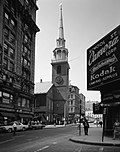Samuel Adams
Samuel Adams (September 27 (OS), 1722 — October 2, 1803) was an American leader, politician, writer, and political philosopher, and one of the Founding Fathers of the United States. Adams helped gather support in the American colonies to rebel against Great Britain. This led to the American Revolution. Adams also shaped the foundations of American politics.
Samuel Adams | |
|---|---|
 | |
| 4th Governor of Massachusetts | |
| In office October 8, 1793 – June 2, 1797 | |
| Lieutenant | Moses Gill |
| Preceded by | John Hancock |
| Succeeded by | Increase Sumner |
| Personal details | |
| Born | September 27, 1722 Boston, Massachusetts |
| Died | October 2, 1803 (aged 81) Boston, Massachusetts |
| Political party | None |
| Spouse(s) | Elizabeth Checkley, Elizabeth Wells |
Born and raised in Boston, Massachusetts, Adams was brought up in a religious family. He was educated at Boston Latin School and Harvard College.
He first became a businessman, but did not like it. He turned his interest instead to politics and became an influential political writer. In his writings, and at town meetings in Boston, Adams urged people to defend their rights and liberties, withdraw from Great Britain, and form a new government.
Adams wrote protests against the taxes that Parliament imposed on the colonies, like the Stamp Act of 1765. He helped to organize the Boston Tea Party in 1773 and was a member of the Continental Congress. At the Second Continental Congress in 1776, he argued for the Declaration of Independence.
Adams helped write the Massachusetts Constitution, along with James Bowdoin and his cousin John Adams. Later, Adams helped draft the Articles of Confederation. After the Revolutionary War ended, he ran for the House of Representatives in the 1st United States Congressional election. He lost the election to Fisher Ames, but was elected Lieutenant Governor of Massachusetts in 1789. After John Hancock's death in 1793, Adams served as the acting governor. He was then elected governor in January 1794. He served in that position until he retired in June 1797 and settled down in his home in Boston. He died six years later on October 2, 1803.
Further reading
Many of the foremost works on Adams' life are from the late 19th and early 20th centuries. Much of the information in more recent biographies comes from these earlier works.
- Alexander, John K. Samuel Adams: America's Revolutionary Politician. Lanham, Maryland: Rowman & Littlefield, 2002. ISBN 0-7425-2115-X.
- Beach, Stewart. Samuel Adams, the Fateful Years, 1764–1776. New York: Dodd, Mead, 1965.
- Cushing, Harry A., ed. The Writings of Samuel Adams. New York: G. P. Putnam's Sons, 1908.
- Fischer, David H. Paul Revere's Ride. New York: Oxford University Press, 1994. ISBN 0-19-508847-6.
- Fradin, Dennis B. Samuel Adams: the Father of American Independence. New York: Clarion Books, 1998. ISBN 0-395-82510-5.
- Hosmer, James K. Samuel Adams. Boston: Houghton Mifflin, 1885.
- Irvin, Benjamin H. Sam Adams: Son of Liberty, Father of Revolution. New York: Oxford University Press, 2002. ISBN 0-19-513225-4.
- Maier, Pauline. From Resistance to Revolution: Colonial Radicals and the Development of American Opposition to Britain, 1765–1776. New York: W. W. Norton, 1992. ISBN 0-393-30825-1.
- Maier, Pauline. The Old Revolutionaries: Political Lives in the Age of Samuel Adams. New York: Alfred A. Knopf, 1980. ISBN 0-394-51096-8.
- Miller, John C. Sam Adams, Pioneer in Propaganda. Boston: Little, Brown and Company, 1936.
- Puls, Mark. Samuel Adams: Father of the American Revolution. New York: Palgrave Macmillan, 2006. ISBN 1-4039-7582-5.
- Wells, William V. The Life and Public Services of Samuel Adams: Being a Narrative of His Acts and Opinions, and of His Agency in Producing and Forwarding the American Revolution, with Extracts From His Correspondence, State Papers, and Political Essays. Boston: Little, Brown and Company, 1865.
Samuel Adams Media
While at Harvard University, Adams boarded at Massachusetts Hall.[1]
The Old South Meeting House (1968 photo shown) was Adams's church. During the crisis with Great Britain, mass meetings were held here that were too large for Faneuil Hall.[2]
Anne Whitney, Samuel Adams, bronze and granite statue, 1880, located in front of Faneuil Hall, which was the home of the Boston Town Meeting[3]
This iconic 1846 lithograph by Nathaniel Currier was entitled "The Destruction of Tea at Boston Harbor"; the phrase "Boston Tea Party" had not yet become standard.
In John Trumbull's Declaration of Independence, Adams is seated to the viewer's right of Richard Henry Lee, whose legs are crossed in the front row.
Samuel Adams grave marker in the Granary Burying Ground
Other websites
| Wikimedia Commons has media related to Lua error in Module:Commons_link at line 62: attempt to index field 'wikibase' (a nil value).. |
- United States Congress. "Samuel Adams (id: A000045)". Biographical Directory of the United States Congress.
- Samuel Adams quotes at Liberty-Tree.ca Archived 2006-05-01 at the Wayback Machine
- Works by Samuel Adams at Project Gutenberg
- Official Commonwealth of Massachusetts Governor Biography
- Biography by Rev. Charles A. Goodrich, 1856 Archived 2007-05-28 at the Wayback Machine
- Encyclopedia Britannica: Adams, Samuel Archived 2007-04-27 at the Wayback Machine
| Political offices | ||
|---|---|---|
| Preceded by Benjamin Lincoln |
Lieutenant Governor of Massachusetts 1789 — 1794 |
Succeeded by Moses Gill |
| Preceded by John Hancock (died) |
Governor of Massachusetts October 8, 1793 — June 2, 1797 (acting, 1793–1794) |
Succeeded by Increase Sumner |
- ↑ Fowler & Fowler 1997, p. 16.
- ↑ Alexander 2002, p. 58.
- ↑ Alexander 2002, p. 48.
- ↑ Wells 1865, p. 334.





